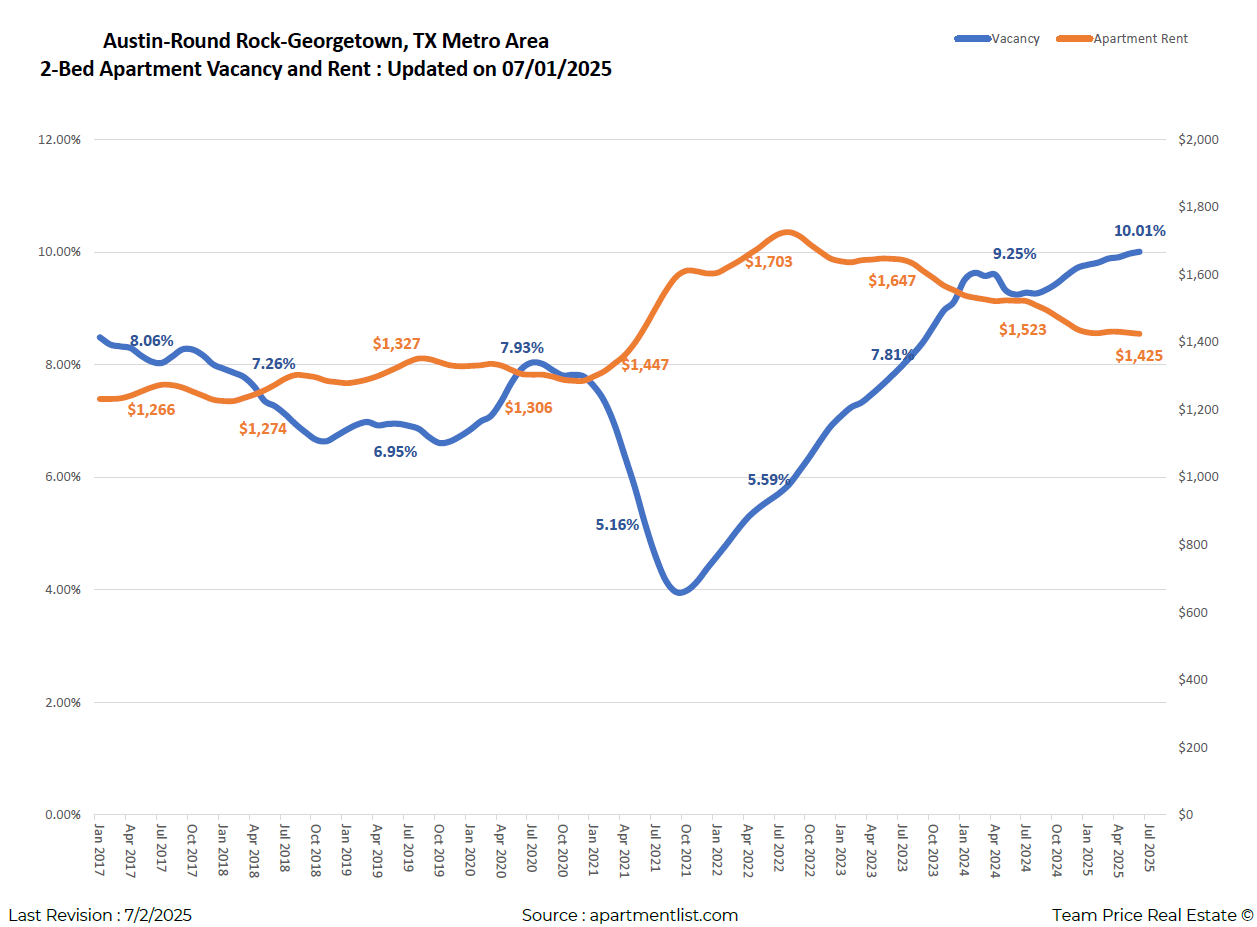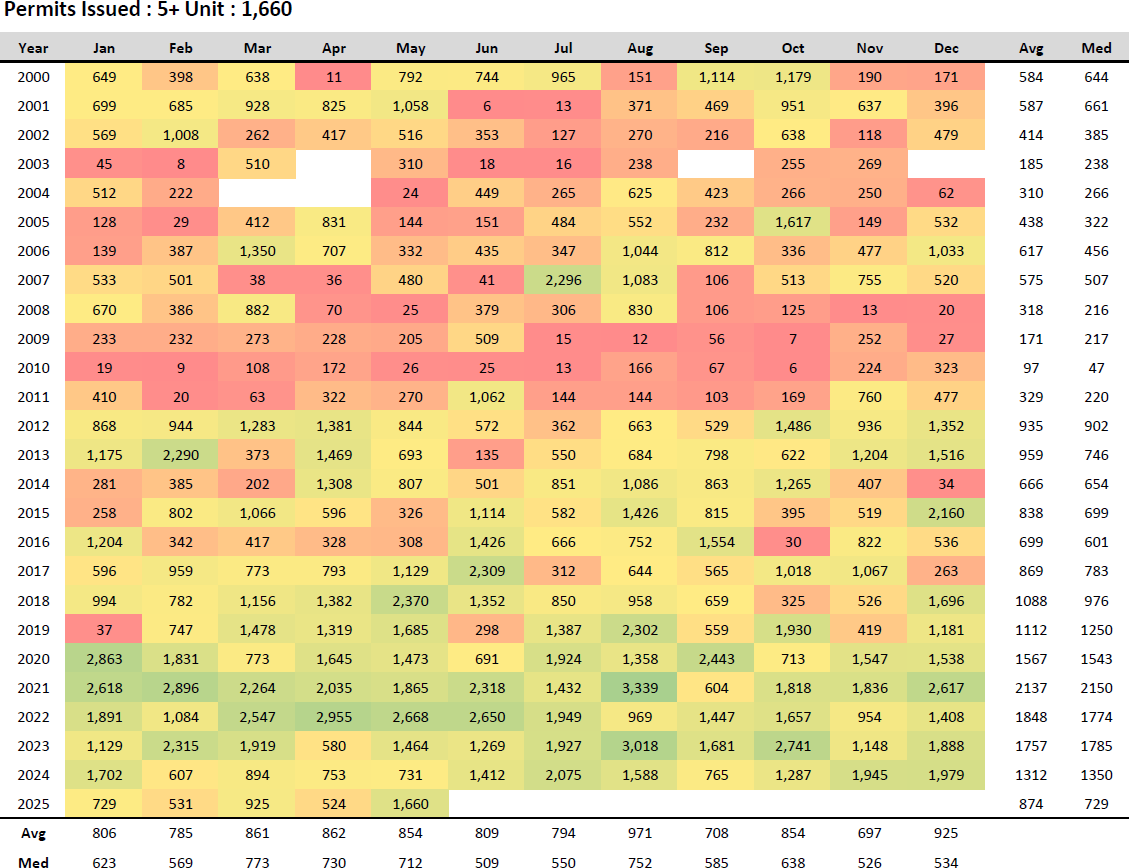Austin Apartment Market Update: Rents Down 17%, Vacancy Hits 10%
Published | Posted by Dan Price
Austin Apartment Market 2025: Vacancy Rates Climb to 20-Year High as Rents Continue to Fall
The Austin-area apartment market is experiencing a significant correction, with vacancy rates climbing to the highest levels in recent history and rents continuing their steady decline. Recent data for June 2025 shows vacancy rates for two-bedroom apartments reaching 10.01 percent, marking a staggering 152.78 percent increase from the market low of 3.96 percent recorded in September 2021. This dramatic shift reflects a classic case of oversupply meeting softening demand, with clear implications for renters, landlords, investors, and policymakers.
The rapid increase in apartment vacancy rates did not happen overnight. The roots of this trend can be traced back to an aggressive period of multifamily development that began several years ago. Between 2019 and 2022, Austin saw an unprecedented surge in building permits for 5+ unit apartment projects, with annual totals consistently exceeding 20,000 units. The peak occurred in 2021, when nearly 25,000 new multifamily permits were issued. These projects, most of which take between 18 and 36 months to complete, are now hitting the market at a time when economic headwinds and affordability concerns are putting downward pressure on rental demand.
As new supply continues to be delivered, competition among property owners has intensified. The most visible result of this is falling rental prices. Two-bedroom apartment rents in Austin peaked in August 2022 at $1,726 per month. Since then, rents have declined by approximately 17.44 percent, reaching $1,425 as of June 2025. This decline in rent pricing is consistent with rising vacancy rates and is being driven by a classic supply-demand imbalance. Even though population growth has been a defining feature of the Austin region over the past decade, the volume of new apartment inventory entering the market has far outpaced demand over the last several years.
While rents have fallen significantly, affordability remains a challenge for many Austin residents. Rent levels are still well above pre-pandemic averages. For comparison, in September 2021, when vacancy rates were at their lowest point of 3.96 percent, the average rent for a two-bedroom apartment was $1,594. Despite the recent price declines, rents today remain roughly 20 percent higher than they were at the beginning of 2021. This suggests that while conditions are improving for renters, affordability has not returned to levels seen before the recent housing boom.
The sharp increase in vacancy rates, coupled with falling rents, raises important questions about the future trajectory of the Austin apartment market. Historical cycles in real estate suggest that once vacancy rates exceed 10 percent, markets often require several years to stabilize, particularly when new supply is still under construction. Data from the first half of 2025 shows that although building permits have slowed from the record highs of 2021 and 2022, they remain elevated by historical standards. Through May 2025, more than 4,300 new multifamily units have been permitted, indicating that additional inventory will continue entering the market well into 2026 and beyond.
These market conditions point to a continued period of softness in the Austin rental market. Renters can expect increased concessions, more available units, and greater negotiating power. Landlords and property managers, on the other hand, face pressure to lower rents, offer incentives, and compete more aggressively for tenants. For developers and investors, the environment has become significantly more challenging, with lease-up periods lengthening and achievable rental rates falling short of pro forma projections made during the 2021-2022 development surge.
Looking ahead, market stabilization will depend on several key factors. First, the pace of new construction must slow to allow excess inventory to be absorbed. Second, job growth and population in-migration must remain strong enough to drive demand for housing. Third, affordability needs to improve to enable a broader segment of the population to participate in the rental market. Until these factors align, elevated vacancy rates and downward pressure on rents are likely to persist.
The current state of the Austin apartment market reflects broader economic principles of supply and demand. When too much inventory is delivered in a short period, and demand fails to keep pace, prices inevitably fall. This correction was predictable based on the aggressive permitting and construction patterns seen in recent years. While this creates challenges for landlords and developers, it also presents opportunities for renters, particularly those who were priced out of the market during the height of the rent surge in 2021 and 2022.
In summary, the Austin apartment market is undergoing a necessary and predictable correction. Vacancy rates have climbed to a 20-year high, rents have fallen by more than 17 percent from their peak, and continued new deliveries suggest softness will persist for the foreseeable future. For those seeking to rent in Austin, the coming months and years may offer more favorable conditions than have been seen in nearly a decade.
FAQ: Austin Apartment Market 2025
Are rent prices going down in Austin?
Yes, rent prices for two-bedroom apartments in Austin have been declining since August 2022. At that time, the average rent peaked at $1,726 per month. As of June 2025, rents have fallen to $1,425, representing a decline of approximately 17.44 percent. This decrease is primarily due to a significant increase in apartment supply and rising vacancy rates.
What is the current apartment vacancy rate in Austin?
The vacancy rate for two-bedroom apartments in Austin as of June 2025 is 10.01 percent. This is the highest vacancy rate recorded in over 20 years and represents a 152.78 percent increase from the market low of 3.96 percent seen in September 2021.
Why are apartment rents in Austin declining?
Apartment rents are declining primarily due to oversupply. Between 2019 and 2022, Austin experienced a surge in multifamily development, with over 20,000 units permitted annually. As these projects have been completed, the market has been flooded with new inventory, leading to increased competition among landlords and downward pressure on rents.
Is the Austin rental market expected to recover soon?
A full market recovery is unlikely to happen quickly. With elevated vacancy rates, falling rents, and additional new supply still in the construction pipeline, market conditions are expected to remain soft through at least 2026. Stabilization will depend on a slowdown in new development and strong job and population growth to help absorb the excess inventory.
Is Austin still considered affordable for renters?
While rents have fallen from their peak, affordability remains a challenge for many renters. Current rents are still roughly 20 percent higher than they were at the beginning of 2021. However, continued rent declines and increased availability may create better conditions for renters in the coming months, especially for those who struggled with affordability during the peak market period.


Related Articles
Keep reading other bits of knowledge from our team.
Request Info
Have a question about this article or want to learn more?


